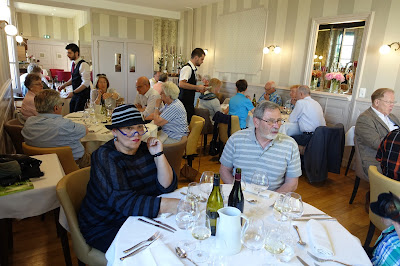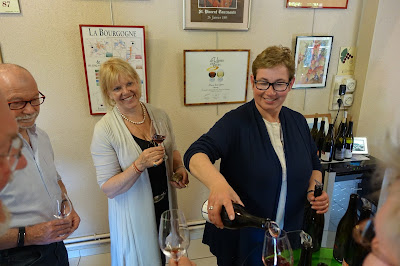Weingut Gunderloch is one of the top producers of Germany. It is located in the small village of Nackenheim in Rheinhessen. This town is situated on the banks of the Rhein in the Rheinterrasse area at the foot of the Rothenberg. This is the famed hillside vineyard site which Nackenheim is known for. Weingut Gunderloch also owns vineyards in the nearby Nierstein in the Red Slope (Roter Hang).
Pictures: Arriving at Weingut Gunderloch, with Agnes, Fritz and Johannes Hasselbach
It all started in 1890, when the banker Carl Gunderloch purchased the Gunderloch manor house in Nackenheim. As the story goes, he used to trek from Gundersblum, his place of birth, to his bank in Mainz. On these journeys he carefully observed how the sun played off the hills along the Rhein terrace. Based on these observations he purchased vineyard property that appeared to collect sunlight most efficiently and founded the Gunderloch Estate. Today, Weingut Gunderloche is still in the hands of the Gunderloch family, with Agnes Hasselbach-Usinger, a descendent of Carl Gunderloch, and her winemaker husband Fritz Hasselbach recently having handed over to their son Johannes Hasselbach.
My wife Annette Schiller and I had the pleasure and honor to participate in the 125 Years Anniversary Celebration.
Picture: 125 Years Gunderloch
Weingut Gunderloch is close to our heart for several reasons. To begin with, when my wife Annette and I studied in Mainz, Germany, and had our first children, we regularly used to go to the cosy wine tavern of Weingut Gunderloch by bike on Sunday afternoon, had a couple of delicious Gunderloch wines and a Spundekäs (local cream cheese) with Bretzels. Second, for the time we have been based in Washington DC (from 1983 onwards) Weingut Gunderloch was one of the leading wine producers in the US. Fritz Hasselbach told me that during the peak, he was once a month in the US, where his wines are imported by Rudi Wiest selections. Third, Johannes Hasselbach is one of the 4 creators of the Wurzelwerk project. Annette Schiller organized their first presentation in the USA last year.
Pictures: Special Tasting with Agnes, Fritz and Johannes Hasselbach at Weingut Gunderloch
Weingut Gunderloch
Weingut Gunderloch has 24 hectares of vineyards. In Nackenheim, there are holdings in the Rothenberg (Riesling), the Engelsberg (Riesling, Silvaner, Ruländer and Gewürztraminer) and the Schmitts Kapellchen (Scheurebe and Müller-Thurgau). In Nierstein, there are holdings in the Pettenthal and Hipping both planted with Riesling and the Paterberg with Ruländer and Müller-Thurgau.
Pictures: Annette and Christian Schiller with Paul Truszkowski (WineVibes.de, drunkenmonday.de, wine-
Overall the vines on the estate have an average age of 25 years, and Riesling predominates as all but 20% of Gunderloch's vines are of this variety. The remainder is mainly Pinot Blanc (5%) and Pinot Gris (5%).
Vineyard practices include hand cultivation, hand harvesting and low yields with an average of 50 hl/ha for the estate as a whole. Once the fruit reaches the winery it is crushed gently without destemming, and then fed by gravity to the vats where it sees a slow, temperature-controlled fermentation to preserve the fruit character of the wines.
Weingut Gunderloch used to be export-oriented and well known in the US, with more than 50% of the production sold abroad. Johannes Hasselbach’s objective is to increase the domestic share in its sales, although the US will always remain a major market for Weingut Gunderloch.
Pictures: Celebrating at Weingut Gunderloch, with Paul Fürst, Weingut Fürst, Jochen Becker-Köhn, Weingut Robert Weil and Roy Metzdorf, Owner of the Legendary Winebar Weinstein in Berlin
The Gunderloch Family
The property and vineyards have remained in family ownership since the days of Carl Gunderloch, who died in 1935, the estate passing first to Gunderloch's granddaughter Elizabeth Usinger and her husband. They remained at the helm until 1965, when their son Carl Otto took on the management of the estate.
Until recently, his eldest daughter, Agnes Hasselbach-Usinger and her husband, Fritz Hasselbach were in charge. Agnes and Fritz developed a strong presence in the US, with wine importer Rudi Wiest in California. Gunderloch wines are available throughout the US.
Agnes and Fritz have 3 children. Daughter Kathrin Hasselbach-Bordiehn is pursuing other interests outside of the estate. Daughter Stefanie Jurtschitsch studied oenologie at Geisenheim University, where she met Alwin Jurtschitsch from the famous Weingut Jurtschitsch in Austria and married into this winery. She lives with Alwin in Austria now and makes Jurtschitsch wines. Son Johannes Hasselbach, with his wife, has taken over the winery. He initially studied business economics before turning to winemaking. It will be interesting to see in what direction Johannes will steer the winery.
Picture: Angela and Peter Jakob Kühn, Weingut Peter Jakob Kühn
Picture: Annette Schiller with Alwin Jurtschitsch, Weingut Jurtschitsch and Julia Klüber, Berlin
Picture: Annette and Christian Schiller with Paul Fürst, Weingut Fürst in Franken
Picture: Christian Schiller with Louis Konstantin Guntrum and Stephanie Streichele-Guntrum, Weingut Guntrum
Picture: Phillip Wittmann, Weingut Wittmann
Picture: Christian Schiller and Roy Metzdorf, Owner of the Legendary Winebar Weinstein in Berlin
German Dramatist Carl Zuckmaier
The Gunderloch Estate also has an interesting tie to the German dramatist Carl Zuckmaier. Zuckmaier, who became a Hollywood screenwriter, was born in Nackenheim and a friend of Carl Gunderloch. Zuckmaier not only wrote the screenplay for the film "The Blue Angel", but also the plays "The Captain from Koepenick" and "The Devils General". He also used the Gunderloch estate for the setting, and Carl Gunderloch as the main character for his very first play "Der fröhliche Weinberg" (the jolly vineyard). In this play Zuckmaier renamed Carl Gunderloch "Jean Baptiste" which is where the brand name used on the Gunderloch "Jean Baptiste" Kabinett is borrowed from.
Pictures: The „Der Fröhliche Weinberg“Show is a about to begin (with Andreas Durst, Weingut Durst)
The Festivities
The celebration took place at Weingut Gunderloch during the last weekend of May. At the center was a special performance of the "Der fröhliche Weinberg" of Carl Zuckmaier at the estate.
Saturday May 30
• 15.00 Special Tasting
• 16.30 Welcome and Presentation of VIRGO
• 20.00 „Der Fröhliche Weinberg“
• 22.30 „After-Party“ with Guest Winemakers Knipser and Jurtschitsch
Sunday, May 31
• 12.00 Uhr Hoffest- Estate Party
Wurzelwerk
“Wurzelwerk und Winzers Beitrag” (Root Work and Winemaker’s Contribution) is a fascinating and much talked about project of 4 winemaker friends/relatives from 3 world class wineries in Germany and in Austria. Starting with the vintage 2012, Max von Kunow (Weingut von Hövel, Saar, Germany), Johannes Hasselbach (Weingut Gunderloch, Rheinhessen, Germany) and Alwin + Stefanie Jurtschitsch (Weingut, Jurtschitsch, Kamptal, Austria) shared a portion of their Riesling grapes with the other 2 wineries and vinified the own portion as well as the 2 portions from the other 2 wineries into 3 separate wines. Thus, they make a total of 9 different wines. The first presentation of the Wurzelwerk project outside of Germany took place in Washington DC and was organized by Annette Schiller.
Picture: Annette Schiller, Ombiasy PR and WineTours, Max von Kunow, Johannes Hasselbach, Alwin Jurtschitsch and Christian G.E. Schiller at BToo in Washington DC
See also:
"Wurzelwerk" Goes America: 3 Vineyards, 3 Winemakers and 9 Wines
VIRGO
VIRGO is another interesting project of Johannes Hasselbach. VIRGO is a wine fermented in the vineyard. The purpose of this is to minimize the impact of wine cellar flora and yeasts on the wine. The grapes come from the Grand Cru vineyard Rothenberg. VIRGO thus could mean: “Vergoren Im Rothenberg Ganz Ohne” (Fermented in the Rothenberg without Anything). Alternatively, it could be the Latin word for virgin.
Picture: Johannes Hasselbach Pouring VIRGO
Johannes started the project with the 2010 vintage (only 2 bottles). Here are the tasting notes of Bernd Klingenbrunn from K&M Gutsweine in Frankfurt for the following 3 vintages (in German).
2011 VIRGO
Klare, saubere Aromatik, nicht zu fruchtüppig, Orangenzeste; wirkt fein und eher filigran, feine Mineralik. Im Vergleich zum GG Rothenberg mit Kellerflora wirkt der VIRGO auf mich etwas feiner, die Säure zeigt sich meiner Meinung auch etwas zurückhaltender. 91/100 Pkt
2012 VIRGO
Steinige, salzige Aromatik. Jahrgangstypisch genauso kraftvoll wie sein “Bruder GG” aus dem Keller. Wirkt in sich geschlossen, viel Energie ausstrahlend, kraftvoll, aber nicht fett, ein in sich ruhender Wein, perfekte Balance, wirkt wie selbstverständlich. Für mich auf gleichem Niveau wie das “normale” Rothenberg GG. 96/100 Pkt.
2013 VIRGO
Kaum vorgeklärt, recht schlank auf mich wirkend, würzig, etwas weniger kraftvoll als der 2012er V.I.R.G.O. Gute Balance. Auf mich wirkt dieser Wein etwas weniger offen wie sein “Keller-Pendant” 92/100 Pkt.
schiller-wine: Related Postings
Weingut Gunderloch – The New Generation: Owner Johannes Hasselbach in Washington DC, US
"Wurzelwerk" Goes America: 3 Vineyards, 3 Winemakers and 9 Wines
Special Wine Event on March 18, 2014, in Washington DC with "Wurzelwerk": 3 Terroirs, 3 Winemakers and 9 Wines
Visiting Agnes and Fritz Hasselbach at their Weingut Gunderloch in Nackenheim, Rheinhessen, German
Riesling Lounge Goes Lomo, Germany
































 Picture: Christian G.E. Schiller and Caroline Diel at Schlossgut Diel
Picture: Christian G.E. Schiller and Caroline Diel at Schlossgut Diel




 Picture: Christian G.E. Schiller with August Kesseler and his Wife in Berlin
Picture: Christian G.E. Schiller with August Kesseler and his Wife in Berlin














































































































































































































